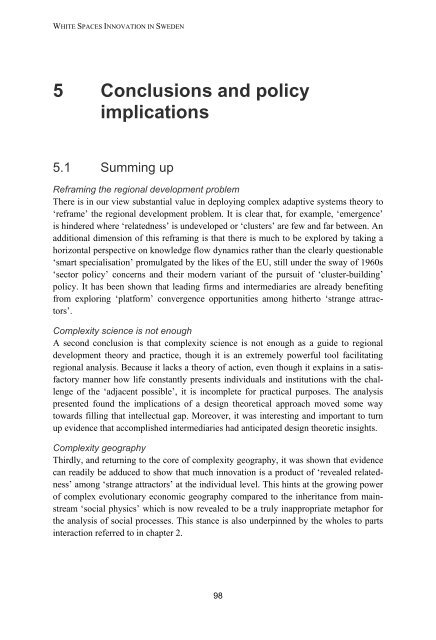White Spaces Innovation in Sweden - Innovation policy for ... - Vinnova
White Spaces Innovation in Sweden - Innovation policy for ... - Vinnova
White Spaces Innovation in Sweden - Innovation policy for ... - Vinnova
Create successful ePaper yourself
Turn your PDF publications into a flip-book with our unique Google optimized e-Paper software.
WHITE SPACES INNOVATION IN SWEDEN5 Conclusions and <strong>policy</strong>implications5.1 Summ<strong>in</strong>g upRefram<strong>in</strong>g the regional development problemThere is <strong>in</strong> our view substantial value <strong>in</strong> deploy<strong>in</strong>g complex adaptive systems theory to„reframe‟ the regional development problem. It is clear that, <strong>for</strong> example, „emergence‟is h<strong>in</strong>dered where „relatedness‟ is undeveloped or „clusters‟ are few and far between. Anadditional dimension of this refram<strong>in</strong>g is that there is much to be explored by tak<strong>in</strong>g ahorizontal perspective on knowledge flow dynamics rather than the clearly questionable„smart specialisation‟ promulgated by the likes of the EU, still under the sway of 1960s„sector <strong>policy</strong>‟ concerns and their modern variant of the pursuit of „cluster-build<strong>in</strong>g‟<strong>policy</strong>. It has been shown that lead<strong>in</strong>g firms and <strong>in</strong>termediaries are already benefit<strong>in</strong>gfrom explor<strong>in</strong>g „plat<strong>for</strong>m‟ convergence opportunities among hitherto „strange attractors‟.Complexity science is not enoughA second conclusion is that complexity science is not enough as a guide to regionaldevelopment theory and practice, though it is an extremely powerful tool facilitat<strong>in</strong>gregional analysis. Because it lacks a theory of action, even though it expla<strong>in</strong>s <strong>in</strong> a satisfactorymanner how life constantly presents <strong>in</strong>dividuals and <strong>in</strong>stitutions with the challengeof the „adjacent possible‟, it is <strong>in</strong>complete <strong>for</strong> practical purposes. The analysispresented found the implications of a design theoretical approach moved some waytowards fill<strong>in</strong>g that <strong>in</strong>tellectual gap. Moreover, it was <strong>in</strong>terest<strong>in</strong>g and important to turnup evidence that accomplished <strong>in</strong>termediaries had anticipated design theoretic <strong>in</strong>sights.Complexity geographyThirdly, and return<strong>in</strong>g to the core of complexity geography, it was shown that evidencecan readily be adduced to show that much <strong>in</strong>novation is a product of „revealed relatedness‟among „strange attractors‟ at the <strong>in</strong>dividual level. This h<strong>in</strong>ts at the grow<strong>in</strong>g powerof complex evolutionary economic geography compared to the <strong>in</strong>heritance from ma<strong>in</strong>stream„social physics‟ which is now revealed to be a truly <strong>in</strong>appropriate metaphor <strong>for</strong>the analysis of social processes. This stance is also underp<strong>in</strong>ned by the wholes to parts<strong>in</strong>teraction referred to <strong>in</strong> chapter 2.98
















